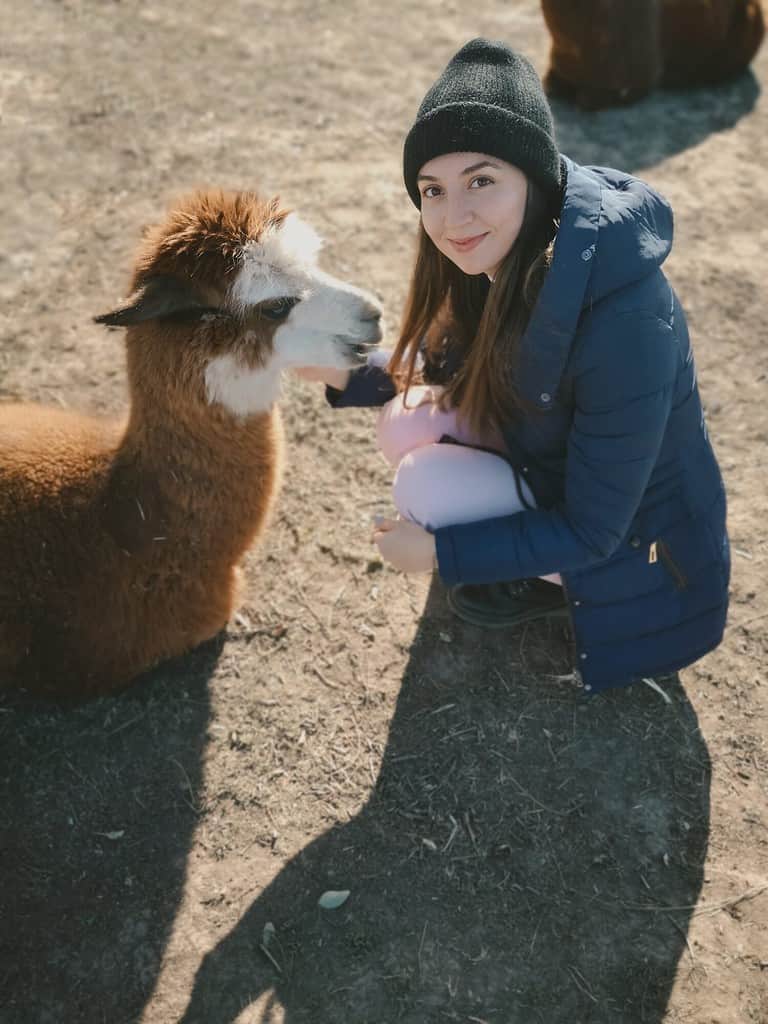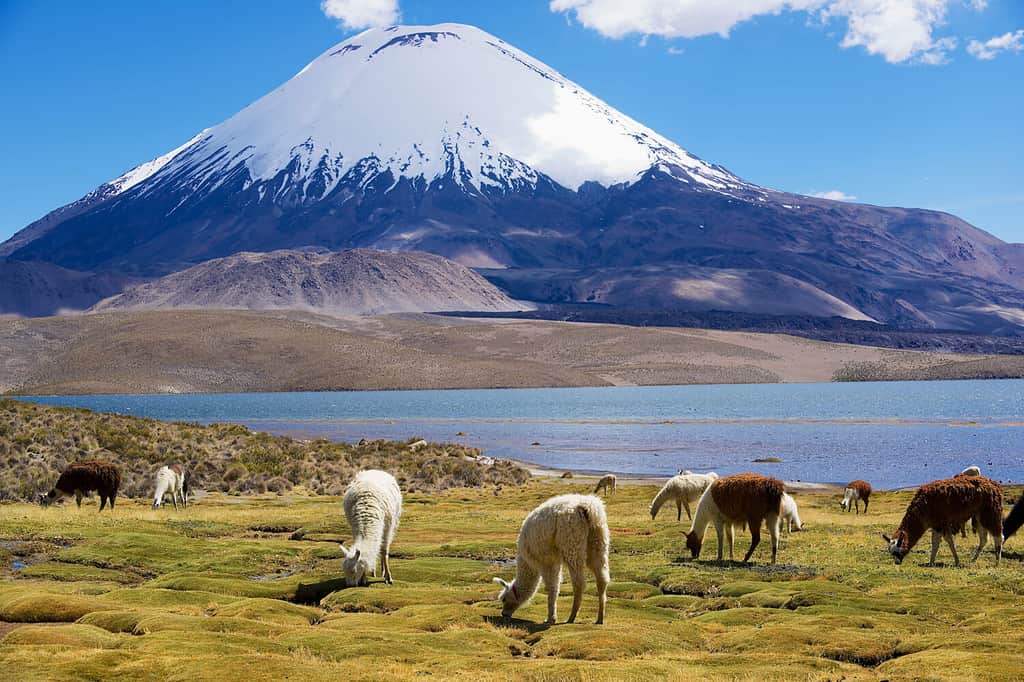Alpacas are animals similar to llamas that are native to South America. For centuries they have been important to indigenous people as pack animals and a source of wool and food. In the United States and other developed countries, alpacas are most often found in petting zoos or as adored family pets. Some people also farm them specifically for their wool, which is of such fine quality and desirable characteristics that it is quite valuable on the market. It’s less common for people in these countries to eat alpaca meat, but in fact, it would be an excellent alternative to beef and other protein sources. Alpacas have far less environmental impact than other livestock raised for meat. Alpaca meat is leaner and healthier than most other protein sources. Read on to find out more benefits of alpacas, and decide not only whether you want to eat them . . . but whether you’d like to raise them as well.
What Is an Alpaca?

Alpacas are small llama-like animals bred for their wool and low-maintenance needs.
©Daria_vg/Shutterstock.com
Alpacas are South American animals related to camels and llamas. They’re smaller than both of those. Typically, they can weigh 100-200 pounds and stand about 32-40 inches at the shoulder. This makes them the same size or even a little smaller than sheep, which weigh anywhere from 99-287 pounds and stand 32-47 inches at the shoulder. Local people bred alpacas mainly for their wool, which means they could also be bred to be small in size, easier to handle, and require less food. Alpacas are herbivores that feed on grass. Living in the high Andes where grass is scarce, they developed the ability to subsist on far less food than comparable grazing animals. Most of the world’s alpaca population today is in Peru.
What Makes Alpaca Meat a Nutritious Option?

Alpaca can be a healthy substitution for beef in most recipes.
©Simon Kadula/Shutterstock.com
Alpaca is a salty, tender, lean, sweet-tasting red meat. It’s high in protein and tastes most similar to beef without leaving a fatty aftertaste. In cooking it tends to take on the flavor of the dish you’re cooking. Chefs recommend cooking it on high heat, turning it once, letting it rest on a warmed plate for several minutes, and serving it rare or medium. It can be substituted for beef in almost any recipe. The Australian Alpaca Association provides some tasty recipes to try out.
Nutritionally, alpaca is closest to pink salmon in its levels of fat and protein. It is one of the lowest-cholesterol meats other than fish you can eat. See for yourself how its nutritional details stack up in the chart below:
| Meat (100 g) | Calories | Fat (g) | Cholesterol (mg) | Protein (mg) |
|---|---|---|---|---|
| Alpaca | 150 | 5.7 | 60 | 23 |
| Pink salmon | 138 | 5.75 | 39 | 20 |
| Venison | 159 | 3.3 | 66 | 25 |
| Turkey | 154 | 3.45 | 68 | 29 |
| Buffalo | 179 | 9 | 71 | 25 |
| Chicken breast | 159 | 3.42 | 83 | 31 |
| Lamb | 213 | 7.62 | 83 | 25 |
| Beef | 214 | 9.76 | 92 | 31 |
| Pork | 219 | 10.64 | 101 | 29 |
How is Alpaca Meat a Sustainable Protein Option?

Alpacas have a very low environmental impact.
©Dmitry Chulov/Shutterstock.com
Here are some of the reasons alpacas are easier on the environment than many other livestock raised for meat:
- They come from an arid climate, so they drink less water and eat less food than other domestic livestock.
- Instead of hooves, they have soft, padded feet that don’t fatally trample down plants and don’t compress the soil.
- Alpacas have only lower teeth, so they pluck the grass gently without disturbing the roots, unlike other grazers that rip it up.
- All parts of the animal are useful: the wool, leather, and meat. Even the leftover bones and waste products can be processed into an additive for pet food or organic fertilizers.
- Their dung doesn’t smell much, and it is high in nitrogen and potassium, making it an outstanding fertilizer.
- Their wool naturally occurs in 24 different color shades, making dye less necessary.
- Alpaca wool is hypoallergenic, water and fire-resistant, and lanolin-free. It does not require special soap or chemical treatments to remove lanolin as other types of wool do.
Where Can You Buy Alpaca Meat?

You can buy alpaca meat online but check the price of shipping as well as the price per pound.
©iStock.com/Andrey Deryabin
If you live near an alpaca farm you might be able to purchase alpaca meat directly from the source. Otherwise, ordering it on the Internet is your best bet. You can find ground alpaca, kabobs, tenderloins, and more. Depending on the cut of meat, you’ll find prices ranging from $12-$30 or more a pound. Pay attention to shipping costs as you comparison shop, as the final price might be cost prohibitive. It may be cheaper to buy from an outfit that charges more per pound, but less for shipping.
Should you Raise Your Own Alpacas?

If you’re going to raise alpacas for meat, you’ll have to think like a farmer.
©Rita_Kochmarjova/Shutterstock.com
You might be thinking you’d like to raise your own alpacas. Here are some things to consider before taking the plunge:
- An individual alpaca sells for anywhere from $250-$2,000. They are social, herd animals so you can’t have just one.
- They are gentle, friendly creatures, easy for people to handle.
- They make good “watchdogs,” spotting predators and announcing the danger. They can be a good addition to a farm with other livestock and crops.
- Being smaller than llamas, they’re easier to handle when shearing or getting veterinary care.
- You’ll have to invest in building a barn and fencing in a large area for them to graze. In the winter they will need hay.
- They must be shorn once a year. If you don’t do it yourself, you’ll have to hire a professional.
- If you just sell the raw fleece you won’t make as much money as if you learn how to process it into a more finished form before selling it.
- Farming livestock means you will be tied to your property every day. The animals need daily feeding, watering, and checking over for injuries or parasites. Depending on the size of your herd, this is an investment of an hour or two in the morning and a couple of hours at night.
- They are very cute, and you will feel like they are pets. Will you have the heart to take them to the slaughterhouse? If not, you might want to choose a smaller, less expensive pet.
Raising alpacas isn’t for everyone, but as these animals become more popular and more available in meat markets, you might want to give it a try, for your health and the health of the planet.
The photo featured at the top of this post is © Canna Obscura/Shutterstock.com
Thank you for reading! Have some feedback for us? Contact the AZ Animals editorial team.







